

A team of scientists studying the origin of SARS-CoV-2, the virus that has caused the COVID-19 pandemic, found that it was especially well-suited to jump from animals to humans by shapeshifting as it gained the ability to infect human cells.
Conducting a genetic analysis, researchers from Duke University, Los Alamos National Laboratory, the University of Texas at El Paso and New York University confirmed that the closest relative of the virus was a coronavirus that infects bats. But that virus’s ability to infect humans was gained through exchanging a critical gene fragment from a coronavirus that infects a scaly mammal called a pangolin, which made it possible for the virus to infect humans.
The researchers report that this jump from species-to-species was the result of the virus’s ability to bind to host cells through alterations in its genetic material. By analogy, it is as if the virus retooled the key that enables it to unlock a host cell’s door — in this case a human cell. In the case of SARS-CoV-2, the “key” is a spike protein found on the surface of the virus. Coronaviruses use this protein to attach to cells and infect them.
“Very much like the original SARS that jumped from bats to civets, or MERS that went from bats to dromedary camels, and then to humans, the progenitor of this pandemic coronavirus underwent evolutionary changes in its genetic material that enabled it to eventually infect humans,” said Feng Gao, M.D., professor of medicine in the Division of Infectious Diseases at Duke University School of Medicine and corresponding author of the study published in Science Advances.
Gao and colleagues said tracing the virus’s evolutionary pathway will help deter future pandemics arising from the virus and possibly guide vaccine research.
The researchers found that typical pangolin coronaviruses are too different from SARS-CoV-2 for them to have directly caused the human pandemic.
However, they do contain a receptor-binding site — a part of the spike protein necessary to bind to the cell membrane — that is important for human infection. This binding site makes it possible to affix to a cell surface protein that is abundant on human respiratory and intestinal epithelial cells, endothelial cell and kidney cells, among others.
While the viral ancestor in the bat is the most closely related coronavirus to SARS-CoV-2, its binding site is very different, and on its own cannot efficiently infect human cells.
SARS-CoV-2 appears to be a hybrid between bat and pangolin viruses to obtain the “key” necessary receptor-binding site for human infection.
“There are regions of the virus with a very high degree of similarity of amino acid sequences among divergent coronaviruses that infect humans, bats and pangolins, suggesting that these viruses are under similar host selection and may have made the ancestor of SARS-CoV-2 able to readily jump from these animals to humans,” said lead co-author Xiaojun Li from Duke.
“People had already looked at the coronavirus sequences sampled from pangolins that we discuss in our paper, however, the scientific community was still divided on whether they played a role in the evolution of SARS-CoV-2,” said study co-lead author Elena Giorgi, staff scientist at Los Alamos National Laboratory.
“In our study, we demonstrated that indeed SARS-CoV-2 has a rich evolutionary history that included a reshuffling of genetic material between bat and pangolin coronavirus before it acquired its ability to jump to humans,” Giorgi said.

